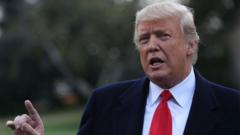The Supreme Court, in a decision announced on Friday, allowed President Donald Trump's executive order to terminate birthright citizenship for those born on U.S. soil to proceed, significantly bolstering his executive powers. Trump referred to the ruling as a “big, amazing decision,” celebrating it as a monumental affirmation of the Constitution and a victory for the rule of law. The Court's ruling, which limits lower courts' ability to issue nationwide injunctions against presidential actions, is set to have profound implications for how future executive orders are enacted.
The ruling allows the Trump administration to implement its controversial birthright citizenship order—although challenges remain due to administrative complications and state-level resistance. States, particularly those governed by Democrats, may delay compliance under the executive order, leading to significant legal challenges ahead. Justice Amy Coney Barrett indicated that states could argue for broader injunctions against the executive order based on potential financial harm and administrative burdens.
With previous instances of executive actions being obstructed by federal judges, the Supreme Court's decision is seen as a pivotal shift that may facilitate the implementation of various Trump policies that had previously been blocked. This includes actions relating to immigration reforms, foreign assistance cuts, and changes to election processes.
Legal scholars point out that while the ruling strengthens presidential action, the courts still retain the power to intervene when actions are deemed unconstitutional. However, the increased leeway for presidents—regardless of party affiliation—could lead to a more assertive executive branch that may push the limits of its authority.
As Trump prepares to move forward with his policy agenda, the implications of this ruling could resonate through future administrations, prompting ongoing debates about the balance of power between the branches of government. The long-term effects of such presidential empowerment hinge on how subsequent legal challenges unfold in the courts and how future presidents choose to navigate this expanded authority.
The ruling allows the Trump administration to implement its controversial birthright citizenship order—although challenges remain due to administrative complications and state-level resistance. States, particularly those governed by Democrats, may delay compliance under the executive order, leading to significant legal challenges ahead. Justice Amy Coney Barrett indicated that states could argue for broader injunctions against the executive order based on potential financial harm and administrative burdens.
With previous instances of executive actions being obstructed by federal judges, the Supreme Court's decision is seen as a pivotal shift that may facilitate the implementation of various Trump policies that had previously been blocked. This includes actions relating to immigration reforms, foreign assistance cuts, and changes to election processes.
Legal scholars point out that while the ruling strengthens presidential action, the courts still retain the power to intervene when actions are deemed unconstitutional. However, the increased leeway for presidents—regardless of party affiliation—could lead to a more assertive executive branch that may push the limits of its authority.
As Trump prepares to move forward with his policy agenda, the implications of this ruling could resonate through future administrations, prompting ongoing debates about the balance of power between the branches of government. The long-term effects of such presidential empowerment hinge on how subsequent legal challenges unfold in the courts and how future presidents choose to navigate this expanded authority.


















